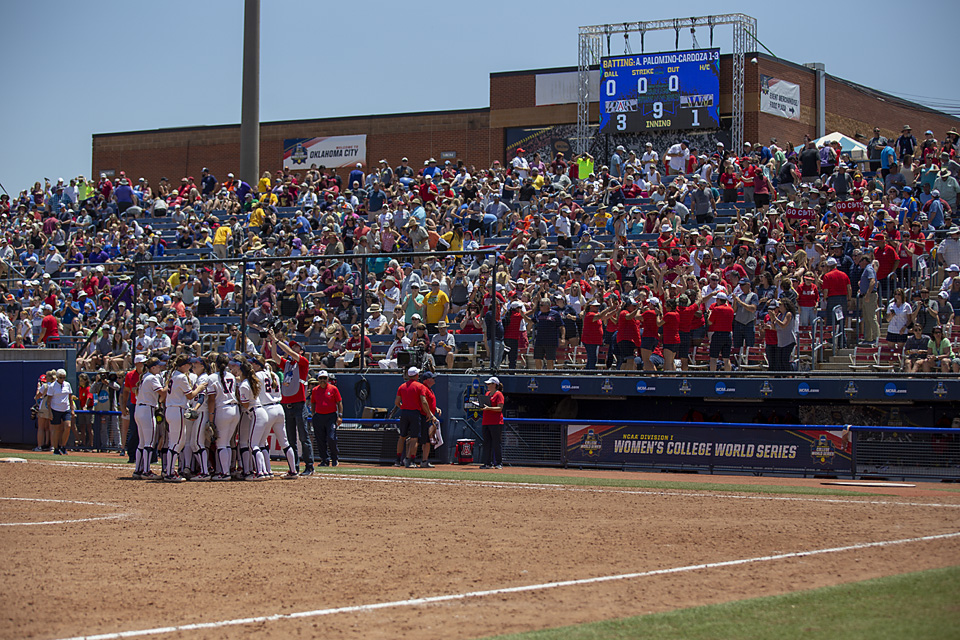The country officially has a decision regarding extended eligibility for spring student-athletes in the wake of COVID-19 cancellations:
DI Council grants waiver to allow additional eligibility for spring sport athletes whose seasons were impacted by COVID-19: https://t.co/v1zriEBDvR pic.twitter.com/g9BbOkmnt0
— NCAA (@NCAA) March 30, 2020
You can find the full release of the Council’s decision, here. Now that collegiate athletics has a direction, what are the questions that remain? While much of the “nitty gritty” is left to be worked out and finalized, here is what we know:
1) What is the short and sweet version?
The NCAA DI Council – which is comprised of college sports administrators representing all 32 D-I conferences and two members of the student-athlete advisory committee – voted to allow a blanket waiver of extended eligibility to all spring student-athletes, including seniors, who would have otherwise exhausted their eligibility following their 2020 campaign. In addition, the Council ruled that institutions will be allowed to make individual decisions rather to offer additional scholarship dollars to returning seniors. They will be allowed to match the previous academic calendar’s aid, offer less, or offer none.
2) What have the praises and criticisms of this been?
In general, there has been an outpouring of positive reactions from coaches, players, media, and more. The biggest criticism, but really more of a commentary, has been the thought that by ruling each institution is able to basically “figure out the financials” for themselves the NCAA is “passing the buck” and positioning institutions and coaches to “look like the bad guys”. While this isn’t completely unfounded, it also isn’t completely accurate. Unless the NCAA was to step in and pay all expense out of its bottom line it’s extremely difficult to mandate a country wide financial course of action; there is too much discrepancy and ceiling for financial capability from one institution to the next (e.g. “Mid-Majors” versus Power 5’s). While it’s easy to assume “that’s just how it should be done”, it’s worth a caution that the financials of this would be crippling and with the loss of revenue from winter championships, spring activities, and with fall activities not yet in the clear it’s not a conversation worth debating until actual figures can be presented.
3) How are roster sizes and scholarship allotments going to work?
Currently, NCAA DI softball does not have a roster limit like baseball does; however, there are travel roster limits that are stipulated by each individual conference. Nothing official has been released from the conferences about their plans to address or extend these roster numbers but as everyone works through this situation we can expect to hear more.
As far as scholarship allotments go, the Council ruled that any returning seniors receiving scholarship money will not count against a program’s allowable count – which is currently 12 for softball. This is important because in most situations there would be no money left for programs to offer to returning seniors. Coaches plan years in advance on how to best leverage their scholarship dollars and when seniors graduate that money has already been allocated to incoming freshmen, potential transfers, and returning student-athletes.
4) What are the opinions and different scenarios for scholarship dollars?
As mentioned there are three options for institutions when it comes to offering any returning seniors extended scholarships: match the previous academic calendar’s aid, offer less, or offer none. This can be done on a case-by-case, student-by-student bases. Important things to remember going into this:
a) Most coaches aren’t going to have much in a say in what kind of extra money they receive to allocate; that is going to come down from athletic directors and administrative departments. Which will be decided on what will surely be an absurd amount of considerations but none more important than, “can this actually be funded”. Keep in mind, departments also have other spring sport programs to attempt to fund as well and funding is more than just a scholarship it’s training table meals, travel, equipment, tutor costs, etc.
b) Again, coaches and institutions don’t have to offer any scholarship money to a returning senior. There could be situations where a coach only offers scholarship money to one or two athletes and none to the rest of the seniors who want to return.
5) Wait, doesn’t that mean things could get a bit awkward?
You are correct, it could. Many coaches across the country have hard decisions and tough conversations on the horizon. It’s also an interesting point to keep in mind when everything is said and done: how will it impact transfers? How could it interfere with team dynamics and relationships going forward?
If you want to go there, conceptually, this arrangement also provides a small taste of what a “pay-for-play” world would look like: what is your direct impact to the outcome on the field and how should you be compensated? That’s great for the talented pitcher but maybe not so much for the individual who has spent most of her career as a role player and pinch runner… But maybe that’s a conversation for another time?
6) What does this do to the ever prevalent transfer portal?
That’s the $64,000 dollar question, isn’t it? Right now, this does not look like a positive step for slowing the transfer game which has already dominated softball’s story lines the last two seasons. Why?
a) It’s likely some programs will not be able to offer a returning senior an extended scholarship, especially at the mid-major level. This opens the door for student-athletes to seek a transfer to another program that can provide scholarship dollars.
b) With the ability for seniors to return, especially impact athletes for their respective programs, roster sizes will expand; potential playing time for other athletes may decrease; and the need for incoming freshmen to red shirt may be present. There are a number of scenarios where student-athletes may want to seek opportunities with other programs.
c) It also sounds like the NCAA/Council will allow returning seniors who would be interested in transferring as a “graduate transfer” to retain their newly granted year of eligibility while allowing programs to offer said transfer more money then they were receiving at their previous institution. However, if this happens, that money would count against the program’s 12 scholarship allotment.
d) More “Mid-Majors” are likely to suffer and lose returning athletes to bigger Power 5 institutions who may be able to fund and offer the money that the smaller schools cannot.
7) What are considerations for seniors to juggle at this time?
For many seniors, there are numerous decision they will need to weight in deciding to return for another year of college and DI softball.
a) The financials of coming back is huge. Softball is an equivalency sport which means of the 12 scholarships coaches have to give out, they are allowed to “break them up” however they see fit. In general, the “full ride” scholarship is softball is rare, so it’s very likely many of the seniors who are entertaining the idea of returning have already paid for some of their first four years and would potentially need to pay even more for their fifth if their program isn’t able to match their scholarship money from the 2019-2020 academic calendar. When you weigh cost of an extra year if said student-athlete doesn’t need it and isn’t starting graduate school it becomes a complex conversation.
b) Many seniors have their “next chapters” in motion. From graduation, graduate school, jobs, etc. there is life after softball and many seniors have those next steps either lined up or in the works. There are many reasons why delaying these things may not be worth it or may not even be possible.
c) Often times one of the best parts of collegiate athletics is an athlete’s teammates. If members of the senior class aren’t returning or younger teammates are transferring this could sway some athletes to not return.
d) Another important factor for some could be simply how their bodies are holding up. Student-athletes put their bodies through a lot over their four years of collegiate ball and if any are injured or their bodies are simply hitting their capacity they may not want to – or can’t – go through another year.
8) What are the trickle down effects on the incoming freshmen class and recruiting for future prospective student-athletes?
a) Incoming freshmen are financially fine, if their NLI is signed, that cannot be broken or reduced unless there is a violation of institutional rules, conduct, etc. The impact on them could be potential travel roster spots and possibility playing time come 2021. That depends on many factors that are yet to be solidified by conferences and institutions.
b) Something to keep in mind, just because the NCAA allows 12 DI softball scholarships per program, that does not mean an institution has to fund them. One course of action a program could choose to take to “make up” any money spent on returning seniors would be to deduct those dollars from future signing classes. I don’t see why anyone would actually want to do this but it may not be avoidable long term.
c) Programs may need to change agreements made to verbal commitments and in some cases may need to revoke offers completely. Changes to a verbal commitment could be scholarship dollars (both amount and annual structure), projected playing time opportunities, the need to red-shirt, a redefining of a PSA’s role within a program, etc.
d) The high school classes of 2021 and 2022 are in an interesting spot, however, we will write another article solely on that shortly. Stay tuned.
9) Long term impact past 2021?
This question will be on-going as the situation plays out both immediately and over the coming year+. Here are a few we can identify right now:
a) Roster management will likely be an ever-evolving challenge for college coaches and programs depending on the size of rosters. This includes impacts such as practice structure, travel rosters, etc. and will be something many coaches are consistently working to management in the coming couple of years.
b) Scholarship funding for current freshmen, sophomores, and juniors. Since all spring athletes received another year of eligibility there are three classes left to figure out but any extended aid will have to count adjust a program’s scholarship allotment – basically, that goes back to normal. This is what I mean by “normal”: should a college coach want to increase a student-athlete’s scholarship they can as long as they have the space within their 12 scholarships to do so, though they are not allowed to lower it once an increase has been made. The NCAA has not said anything regarding extended funding that does not count against the 12 scholarships for any class outside of the seniors – nor will that probably change. So, it will be up to the programs and the student-athletes to figure out how to move forward. If a program can offer money, do they want to? If a student-athlete can stay another year will they even take it, especially the current underclassmen? What lasting impact does it have on the transfer portal? All remains to be seen.
c) We may see a number of commitment shifts from high school aged recruits once programs are able to map out what their needs and capabilities for funding look like.
d) No one has been able to put timeline on the length of impact but it’s reasonable to assume this will have at least a three year on-going impact if not longer.
MISC:
Here is a great news story that was run about MTSU and the perspective of a mid-major during this time:
https://www.wsmv.com/sports/ncaa-approves-extra-year-of-eligibility-for-spring-athletes/video_eb2799d0-c71f-5113-90e5-41721142ad57.html?utm_medium=social&utm_source=twitter&utm_campaign=user-share


